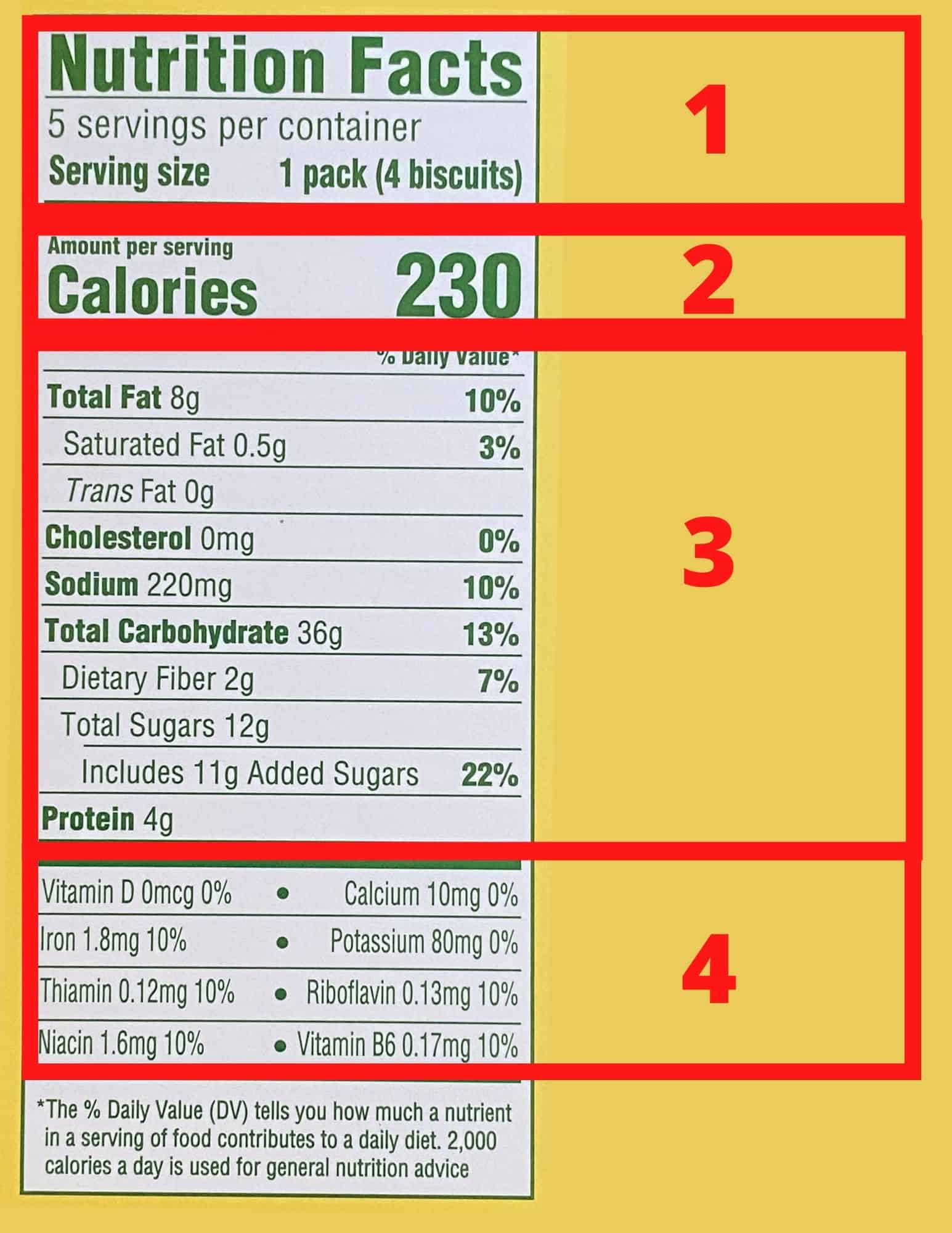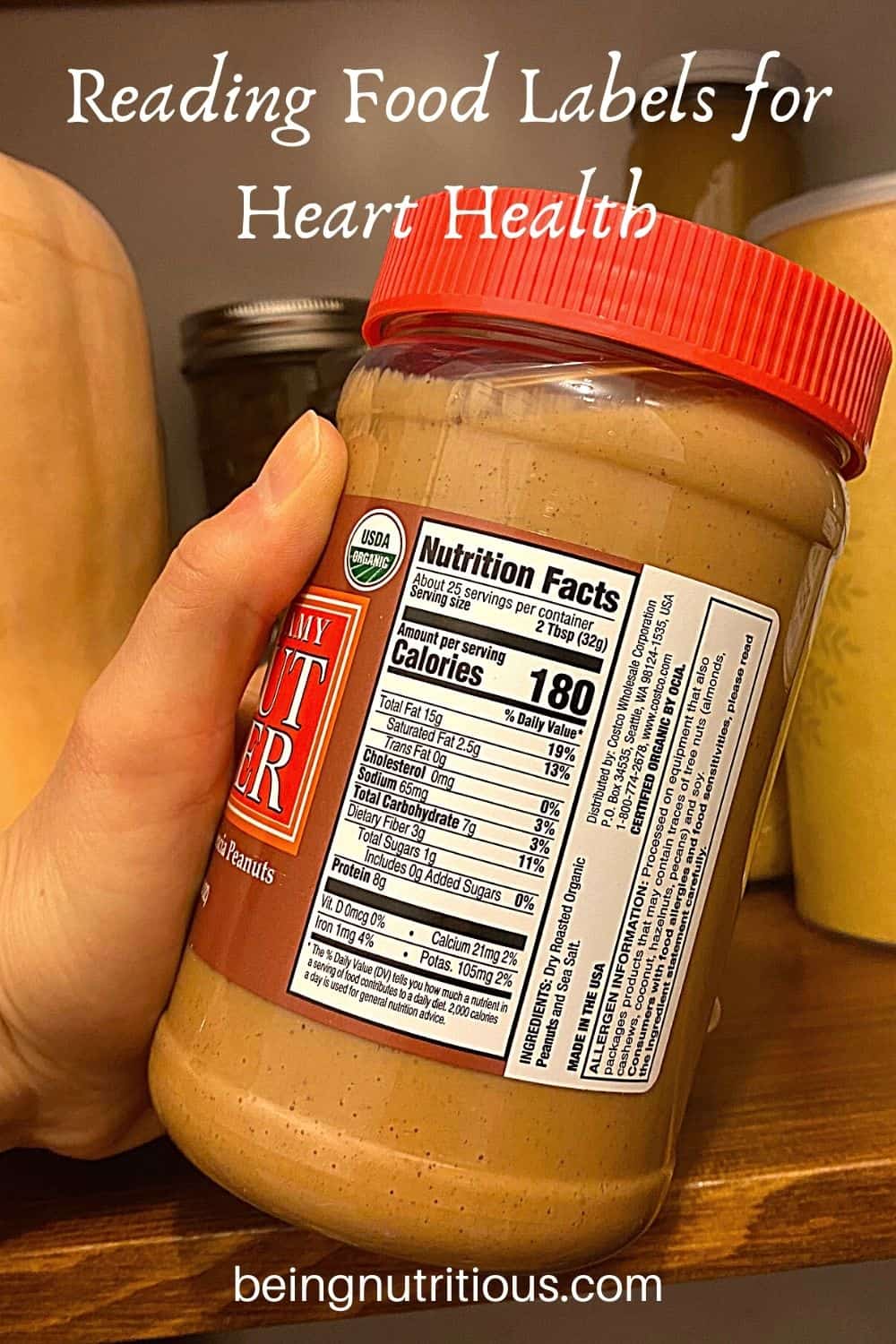Do you know how to read food labels to make heart healthy food choices? If you’re not used to it, it can be an adjustment and takes practice. In this article, we review all the important information you need to know to make the heart healthiest choices at the grocery store!
Let's use this label for reference:

You can see the label is divided into 4 important sections. Use these links to skip to the sections you need more information about, if you don't need all the information in this article!
- Section 1: Serving Size information
- Section 2: Calories
- Section 3: Macronutrients and other key nutrients
- Section 4: Important Vitamins and Minerals
Section 1: Serving size information
This is a very important section of the label. This section tells you how much of that food contains the rest of the nutrition on the label. It also may tell you how many servings are in the whole container. This label comes from a box of individually packaged biscuits. So, in this case, the serving size is one pack, containing 4 biscuits. You may need to measure the food to get the correct serving size. Note that there is no standard serving size. Companies generally choose whatever seems reasonable for their product, but can vary widely between brands. Also, just because the serving size is listed as a particular amount doesn’t mean that’s all you can or should eat. Just know that if you eat 2 or 3 servings, you will have eaten 2 or 3 times all the nutrition on the label.
Section 2: Calories
A calorie is a unit of energy. This part of the label tells you how many calories are in one serving of the food. Calories aren’t “bad.” We need to eat calories to sustain our lives and the things we want and need to do every day. Constantly consuming too many calories can lead to weight gain. Constantly consuming too few calories can lead to weight loss. It’s also important to know that these outcomes will occur regardless of the source of calories. A calorie is calorie, and our body can’t tell the difference between a calorie from a chocolate bar and a calorie from lettuce. However, every calorie does come packaged with different nutrition. And that’s where the healthfulness of the food comes in, and the importance of reading the rest of the label.
Section 3: Macronutrients and other key nutrients
Macronutrients are fat, carbohydrates, and protein. You can see these are further divided into subcategories and there are a couple extras that aren’t macronutrients. There are also percent daily values listed on the right hand side of the label. This can be useful to help you balance choices, but know these values are based on a 2000 calorie diet, so your personal needs may be more or less depending on your individual calorie needs. All foods and beverages are some combination of the three main macronutrients (alcohol is a fourth macronutrient, but is usually only included on alcoholic beverages). Like calories, none of these nutrients are “bad,” and we need them all, except cholesterol and added sugar, in different amounts.
Total Fat
We know that the type of fat matters more than the total amount of fat eaten. Still, eating too much fat means you may not be eating enough of something else. Plus, fat does have a lot more calories than either carbohydrates or protein. A moderate amount of fat is recommended. About 30% of your daily calories is a good amount to ensure proper absorption of vitamins, satiety, and satisfaction, without going overboard.
Saturated Fats
Saturated fat is a type of fat that can contribute to high cholesterol levels if eaten in excess. Some people are also more sensitive to it, and tend to produce more cholesterol as a result. If you have high cholesterol, you should take steps to limit (not eliminate) the amount of saturated fat you consume. Less than 10% of total calories is recommended. Your doctor may recommend even less depending on your situation.
Trans Fats
Trans fats are unsaturated fats that are artificially saturated using a process called hydrogenation. These fats are even more harmful to your health than saturated fats, and contribute no beneficial effects. While trans fats are being phased out of the food supply, you may still find them in some products. You should avoid all trans fats if possible. Double check the ingredient list and look for partially hydrogenated oils (these are trans fats).
Monounsaturated and Polyunsaturated Fats
These fats are not required to be on labels, so you may or may not see them listed. These are heart healthy fats. They do slightly different things for our hearts, but the important thing to remember when you read labels is that these are healthier than the other types of fats, and you should choose products higher in these.
Cholesterol
Cholesterol isn’t a fat. It’s a waxy substance that our bodies use to make new cells and for other processes. Our bodies need cholesterol. However, for some of us, too much cholesterol can be produced, leading to clogged arteries and an overall increased risk of heart attack and stroke. Most of the cholesterol we eat doesn’t lead to increased cholesterol in the blood, but it can for some people. It’s also not necessary to eat cholesterol, since the body makes it mainly from saturated fats. There’s no recommended limit on cholesterol anymore for healthy people, but if you have high cholesterol, you may consider limiting it in case you are more sensitive to it.
Sodium
Sodium is a big concern for many of us. We know sodium contributes directly to blood pressure increases. We should all be consuming less of it, but especially those of us with high blood pressure. Read more about the link between sodium and blood pressure here. A good rule of thumb is to look for snacks under 150mg sodium per serving, and prepared meals under 500mg total. Those are generous, as the limit for sodium is 1500mg per day. You can see how quickly that adds up!
Total Carbohydrates
Like total fat, the amount of total carbohydrates matters less than the type of carbohydrates. Carbohydrates are important to help with the production of energy, as well as some hormones. Roughly 40-60% of your total calories should be carbohydrate, but remember to look below the total at the types of carbohydrates that mainly make up the product.
Fiber
Fiber is a type of carbohydrate that we can’t digest, but is very important, especially for heart health. The vast majority of us don’t get anywhere close to eating the amount of fiber we should. There is no upper limit for fiber intake, but women under 50 should consume at least 25 grams per day, and women over 50 should consume at least 21 grams per day. Men under 50 should consume at least 38 grams per day, and men under 50 should consume at least 35 grams per day. Learn more about fiber and heart health in our article.
Choose products that have at least a few grams of fiber. More is better, but remember that fiber is naturally occurring only in whole plant foods: whole grains, fruits, vegetables, nuts, seeds, and beans. Animal foods like meat, cheese, milk, butter, and eggs have no natural fiber.
Total Sugars
Sugars are another type of carbohydrate. There are two types of sugars that are included in total sugars, and they are not created equal. To know whether the total sugar amount is a concern or not, look below at the amount of added sugar.
Added sugar can contribute extra calories, and lead to heart disease, among other health problems, in excess. They also taste good! Added sugars include sweeteners like table sugar, brown sugar, corn syrup (including high fructose corn syrup), honey, molasses, and many, many more.
Naturally occurring sugars are those that are not added, but are inherently part of the food. Products like fruit and fruit products, vegetables, milk, and yogurt all have naturally occurring sugars. There is no recommended limit on naturally occurring sugar.
Products typically contain some combination of naturally occurring and added sugars. Look for products that contain as little added sugars as possible. The American Heart Association recommends no more than 36 grams of added sugar per day for men, and no more than 25 grams of added sugars per day for women. Added sugars, like sodium, can add up quickly throughout the day. It may be obvious that products like cookies, cakes, and pies are high in sugar, but it’s also in products like creamers, (most) cereal, oatmeal packets, yogurt, breads, salad dressings and sauces/condiments.
Protein
Protein is an important building block for all the cells in your body, and multiple processes. Getting adequate protein isn’t a problem for most people. Most of us eat much more protein than we need, actually. About 20-30% of calories, give or take, should be from protein.
If you find you are in the majority, in that you consume more protein than needed, consider decreasing your amount of protein, and increasing the amount of something else you don’t eat enough of - like fiber or healthy fats.
Section 4: Important Vitamins and Minerals
In section 4, you will see at least 4 nutrients listed, calcium, vitamin D, iron, and potassium. These are nutrients many people don’t get enough of. You may see others listed in addition, at the manufacturer’s discretion. Both the actual amount and % daily value are listed, since not all people have the same needs.
Reading food labels can be confusing, but with a little practice, you can become a pro! What’s the most confusing part of how to read food labels for you? Let me know in the comments below!


Leave a Reply